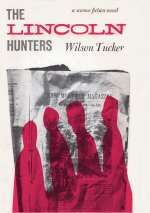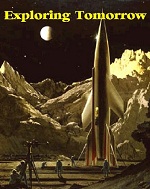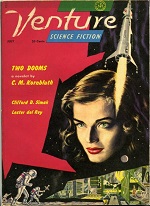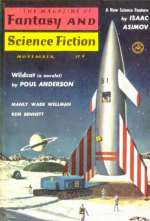|  | | | | 

| | The Lincoln Hunters
by Wilson Tucker
First publication: 1958

When a time travel novel brags the title The Lincoln Hunters, you more-or-less expect a mad race to stop John Wilkes Booth, but Tucker’s book instead focuses on Benjamin Steward, an agent of Time Researchers who is pegged to lead a team from the year 2578 back to 1856 Bloomington, Illinois, where they plan to record Lincoln’s lost speech condemning slavery. Full of fire and energy and force; it was logic; it was pathos; it was enthusiasm; it was justice, equity, truth and right, the good set ablaze by the divine fires of a soul maddened by the wrong; it was hard, heavy, knotty, gnarled, edged and heated, backed with wrath. Full of fire and energy and force; it was logic; it was pathos; it was enthusiasm; it was justice, equity, truth and right, the good set ablaze by the divine fires of a soul maddened by the wrong; it was hard, heavy, knotty, gnarled, edged and heated, backed with wrath. 
| |
| | | | |

 
 
 | | | | 

 Host John W. Campbell, Jr., by Frank Kelly Freas Host John W. Campbell, Jr., by Frank Kelly Freas

| | Exploring Tomorrow
hosted by John W. Campbell, Jr.
First time travel: 29 Jan 1958

From Dec 1957 to Jun 1958, John W. Campbell himself hosted this radio series for the Mutual Broadcasting System. Many episodes were written by John Flemming, and although there was no official connection between the show and Campbell’s Astounding, many other scripts were by Campbell’s stable of writers including Poul Anderson, Isaac Asimov, Philip K. Dick, Gordon R. Dickson, Murry Leinster, Robert Silverberg and George O. Smith (“Time Traveler”). There were at least three time-travel episodes.- Flashback (1/29/58) new father flashes forward to war
- Time Traveler, aka Meddler’s Moon (5/21/58) 50 years back to grandparents
- The Adventure of the Beauty Queen (6/25/58) love from the future
 You’ve got a son to take care of you in your old age, Mr. Thompson. You’ve got a son to take care of you in your old age, Mr. Thompson. 

—from “Flashback”
| |
| | | | |

 
 
 
 | | | | 

| | Tales of Magic #4
The Time Garden
by Edward Eager
First publication: Mar 1958

Janet found this one for me, and it was the first of the series that I read. The story returns to Roger, Ann, Jane, and Mark from the second book. This time, a grumpy garden toad tells them of the magical powers of thyme. The magic takes the quartet back to the American Revolution, the time of American slavery, and an encounter with their own mothers and uncles (which we’ve already seen from the older generation’s point of view in the third book). There’s also a cameo by the children from E. Nesbit’s The Phoenix and the Carpet. Because what if it did happen like that, and the young Jane and Mark and Katharine and Martha came back with them to modern times? He could think of two ways it might work out. They might take the place of their grown-up selves, and there wouldn’t be any grown-up Jane and Mark and Katharine and Martha any more, and that would be awful. Because nice as the small Martha was, as a parent she just wouldn’t do. Because what if it did happen like that, and the young Jane and Mark and Katharine and Martha came back with them to modern times? He could think of two ways it might work out. They might take the place of their grown-up selves, and there wouldn’t be any grown-up Jane and Mark and Katharine and Martha any more, and that would be awful. Because nice as the small Martha was, as a parent she just wouldn’t do.
 Or else there Jane and Mark and Katharine and Martha would be, and there their grown-up selves would be, too, and they might bump right into each other. And that would be like those horror stories where people go walking down long hallways and meet themselves coming in the other direction. And everybody goes mad in the end, and no wonder! Or else there Jane and Mark and Katharine and Martha would be, and there their grown-up selves would be, too, and they might bump right into each other. And that would be like those horror stories where people go walking down long hallways and meet themselves coming in the other direction. And everybody goes mad in the end, and no wonder! 
| |
| | | | |

 
 | | | | 

| | “Two Dooms”
by C.M. Kornbluth
First publication: Venture Science Fiction, Jul 1958

Young Dr. Edward Royland, a physicist at Los Alamos in 1945, travels via a Hopi God Food to the early 22nd century to see what a world ruled by the Axis powers will be like—and quite possibly setting off a seemingly endless sequence of alternate WWII stories such as The Man in the High Castle, most of which, sadly, do not include time travel.

I liked Kornbluth’s description of the differential analyzer as well as the cadre of office girls solving differential equations by brute force of adding machines. Instead of a decent differential analyzer machine they had a human sea of office girls with Burroughs’ desk calculators; the girls screamed “Banzai!” and charged on differential equations and swamped them by sheer volume; they clicked them to death with their little adding machines. Royland thought hungrily of Conant’s huge, beautiful analog differentiator up at M.I.T.; it was probably tied up by whatever the mysterious “Radiation Laboratory” there was doing. Royland suspected that the “Radiation Laboratory” had as much to do with radiation as his own “Manhattan Engineer District” had to do with Manhattan engineering. And the world was supposed to be trembling on the edge these days of a New Dispensation of Computing that would obsolete even the M.I.T. machine—tubes, relays, and binary arithmetic at blinding speed instead of the suavely turning cams and the smoothly extruding rods and the elegant scribed curves of Conant’s masterpiece. He decided that he would like it even less than he liked the little office girls clacking away, pushing lank hair from their dewed brows with undistracted hands. Instead of a decent differential analyzer machine they had a human sea of office girls with Burroughs’ desk calculators; the girls screamed “Banzai!” and charged on differential equations and swamped them by sheer volume; they clicked them to death with their little adding machines. Royland thought hungrily of Conant’s huge, beautiful analog differentiator up at M.I.T.; it was probably tied up by whatever the mysterious “Radiation Laboratory” there was doing. Royland suspected that the “Radiation Laboratory” had as much to do with radiation as his own “Manhattan Engineer District” had to do with Manhattan engineering. And the world was supposed to be trembling on the edge these days of a New Dispensation of Computing that would obsolete even the M.I.T. machine—tubes, relays, and binary arithmetic at blinding speed instead of the suavely turning cams and the smoothly extruding rods and the elegant scribed curves of Conant’s masterpiece. He decided that he would like it even less than he liked the little office girls clacking away, pushing lank hair from their dewed brows with undistracted hands. 
| |
| | | | |

 
 
 
 
 
 | | | | 

| | “Wildcat”
by Poul Anderson
First publication: The Magazine of Fantasy and Science Fiction, Nov 1958

Herries, the leader of 500 men drilling for oil in the Jurassic, wonders about free will and the eventual fate of twentieth century America and its nuclear-armed adversaries.

The story was a nice forerunner to Silverberg’s “Hawksbill Station.” But we are mortal men. And we have free will. The fixed-time concept need not, logically, produce fatalism; after all, Herries, man’s will is itself one of the links in teh causal chain. I suspect that this irrational fatalism is an important reason why twentieth-century civilization is approaching suicide. If we think we know our future is unchangeable, if our every action is foreordained, if we are doomed already, what’s the use of trying? Why go through all the pain of thought, of seeking an answer and struggling to make others accept it? But if we really believed in ourselves, we woiuld look for a solution, and find one. But we are mortal men. And we have free will. The fixed-time concept need not, logically, produce fatalism; after all, Herries, man’s will is itself one of the links in teh causal chain. I suspect that this irrational fatalism is an important reason why twentieth-century civilization is approaching suicide. If we think we know our future is unchangeable, if our every action is foreordained, if we are doomed already, what’s the use of trying? Why go through all the pain of thought, of seeking an answer and struggling to make others accept it? But if we really believed in ourselves, we woiuld look for a solution, and find one. 
| |
| | | | |

 
No Time Travel. Move along. |
“That Hell-Bound Train” by Robert Bloch, F&SF, Sep 1958 [stopping time ]

“The Last Paradox” by Edward D. Hoch, Future Science Fiction, Oct 1958 [bizarre physiological aging ]

| |     |